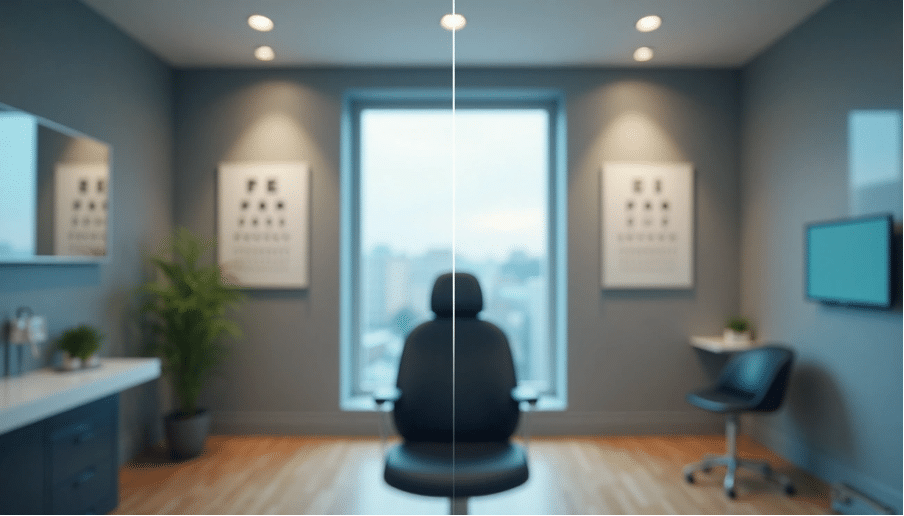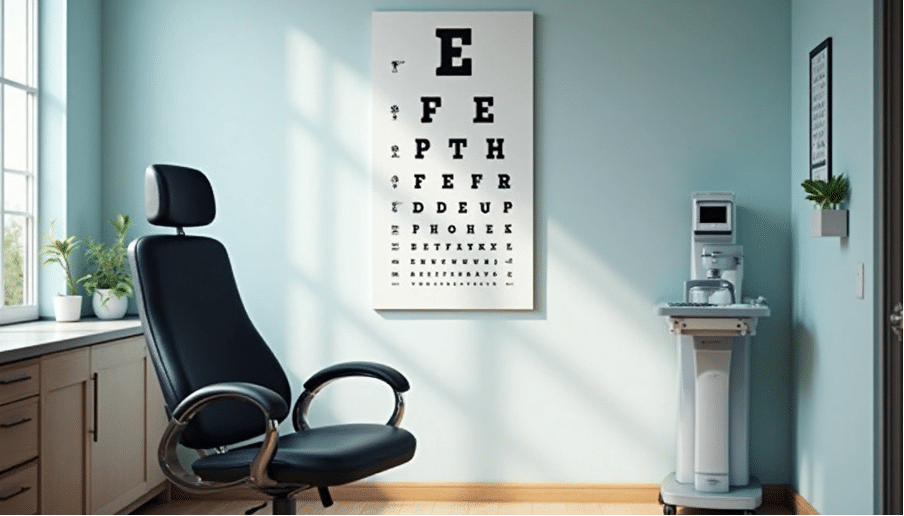Do you find it hard to tell the difference between short sighted and long sighted vision problems? Vision correction matters now more than ever, with half of the UK population dealing with short-sightedness. Research suggests that by 2050, half of the world’s population will face similar issues.
Your vision might make distant objects look blurry, or you might struggle to read things up close. The difference between long and short sighted conditions plays a vital role in finding what works for you. Short-sightedness (myopia) makes distant objects appear blurry, while long-sightedness (hypermetropia) affects your close-up vision. The good news is that both conditions respond well to different treatments. Laser eye surgery can reshape your cornea to improve vision for both conditions.
Our expert surgeons at Precision Vision London use the latest technology to give personalised care for vision correction. This piece will help you figure out if you’re short or long sighted and guide you through your treatment options. Let’s look at what makes these common vision conditions different and help you find the perfect solution for your eyes.

Am I Short or Long Sighted? Spotting the Signs Early
Early detection of vision problems helps you get treatment at the right time. Your daily activities often reveal whether you have short-sightedness or long-sightedness.
Difficulty Reading or Driving: What It Could Mean
People with short-sightedness (myopia) see distant objects as blurry while close items remain clear. Reading road signs, viewing whiteboards, or recognising faces from a distance becomes challenging. Long-sightedness (hypermetropia) affects nearby vision while distant objects stay relatively clear. Reading books, using phones, or looking at computer screens becomes difficult. Children might not tell you about their vision problems. They show signs like squinting, sitting too close to screens, and rubbing their eyes often. These kids might seem unaware of objects far away. Adults typically notice they can’t read street signs or store displays clearly.
Squinting, Eye Fatigue, and Other Red Flags
Blurry vision isn’t the only symptom these conditions share. Your eyes might feel strained and you could experience headaches or double vision. Light sensitivity, watery eyes, or dry eyes that itch and burn are common signs too.
Watch out for these warning signs:
- Reading materials held at arm’s length
- Problems adjusting to dark rooms
- Bright lights surrounded by halos
- Too much blinking or eye rubbing
Important: Get medical help right away if your vision changes suddenly, especially with pain. These symptoms might indicate serious conditions.
How Vision Tests Help Identify Refractive Errors
Eye examinations are vital to diagnose vision problems accurately. Your optometrist uses a refraction test to check how light bends through your eye’s lens. You’ll read letters from a distance chart as different lenses are placed in front of your eyes. Children should have vision tests between ages 3-5 and yearly checks from age 6. Adults under 40 with good vision need tests every 2-5 years. The frequency increases as you get older.
Getting the Right Diagnosis: What to Expect at Your Eye Exam
Your vision correction journey starts with the right diagnosis. When you notice changes in your vision, a detailed eye examination will tell you if you’re short-sighted, long-sighted, or dealing with both conditions.
Visual Acuity and Refraction Tests
The eye examination starts with a visual acuity test. The familiar Snellen chart shows letters that get smaller as you read down. This test gives us a full picture of your vision’s sharpness and creates a baseline for your eye health. Your optometrist then uses a refraction test to measure any refractive errors. You’ll look through different lenses in a device called a phoropter while reading letters on a chart. By asking which lenses help you see the letters most clearly, the optometrist can determine your ideal prescription.

3D OCT Scanning
Advanced Optical Coherence Tomography (OCT) scanning – a non-invasive imaging technology that captures over 1,000 images of your eye. OCT provides detailed cross-sectional images of your retina’s layers, unlike standard eye tests. Specialists can spot potential issues up to five years earlier than traditional methods. This technology works like an “optical ultrasound” and reveals structures beneath the surface that stay hidden during routine examinations.
Understanding Your Prescription: Positive vs Negative Lenses
Your prescription after the examination will have specific numbers that show your vision correction needs:
- Negative numbers (-) show short-sightedness (myopia), which means you need help seeing distant objects clearly
- Positive numbers (+) show long-sightedness (hyperopia), meaning you need help with near vision
The further your prescription number moves from zero (either way), the stronger correction you need. Your prescription might also include measurements for astigmatism (CYL) and its orientation (AXIS) if your eye’s front surface isn’t perfectly spherical. Regular detailed eye examinations matter – experts suggest checks every two years for most adults, and yearly checks for people with existing conditions.
Choosing the Best Vision Correction for Your Needs
Your next big decision after a diagnosis of short-sightedness or long-sightedness is choosing the right vision correction method. The best solution depends on your needs, lifestyle, and eye health.
Glasses vs Contact Lenses: Pros and Cons
Glasses are simple to use and you don’t need to touch your eyes. They give you excellent peripheral vision without any risk of eye infections. They need minimal care and last for years when properly maintained. Contact lenses give you more natural vision because they move with your eyes. They won’t fog up in cold weather or during sports. The downside is that contacts need careful cleaning (except daily disposables). Some people experience dryness or irritation while wearing them. Your treatment should match your lifestyle and eye health whether you have short-sightedness or long-sightedness. We tailor vision solutions just for you at Precision Vision London. Book your expert consultation today.
Laser Eye Surgery for Short-Sightedness and Long-Sightedness
These laser procedures work well to correct both vision conditions:
- LASIK reshapes the cornea by creating a thin flap. Recovery is faster compared to surface treatments
- LASEK/PRK treats the corneal surface directly. Doctors recommend this for patients with thinner corneas
- SMILE creates a small keyhole opening with a tiny incision. This reduces dry eye risk
About 94% of patients achieve 20/20 vision or better after laser surgery. Patient satisfaction reaches 98.5%.
Refractive Lens Exchange and Duet Lens Options
Refractive Lens Exchange (RLE) uses a synthetic implant to replace your natural lens and correct vision errors. The procedure shows excellent results – 95% of patients achieve driving standard vision or better. The innovative Duet procedure combines a standard lens with a supplementary Sulcoflex lens. Patients can adjust their vision later if needed. This works well for people who want multifocal benefits with a reversible option.

Who is Suitable for Which Procedure?
Laser vision correction works best for patients who:
- Are 21 or older with stable prescriptions
- Have healthy eyes and good general health
- Have prescriptions within certain ranges (up to +3/+4 for long-sightedness, up to -10 for short-sightedness)
RLE might be better for people who:
- Are 40 or older or show early cataract formation
- Have prescriptions beyond laser surgery ranges
- Want to avoid future cataract surgery
Your unique vision profile determines the best approach. Our specialists can give you a full picture through detailed assessment.
Living with Vision Correction: What to Expect After Treatment
Your experience with vision correction continues well after you get new glasses or complete surgery. Getting used to better vision takes time and proper care after treatment.
Adjusting to New Glasses or Lenses
The original adjustment to new glasses takes about 2-3 days, though some people need up to two weeks. Your brain and eyes need time to work with the new prescription or frame style. You might notice blurry vision, eye strain, headaches, and sometimes a “fishbowl effect” that makes edges of your vision look bent.
These tips help you adapt better:
- Put your new glasses on first thing in the morning
- Add more wearing time each day
- Keep your old glasses away
- Turn your head instead of just your eyes when using multifocal lenses
Post-Surgery Recovery and Results
Your eyes need time to heal after laser eye surgery. LASIK patients usually see better within 24 hours, while LASEK recovery needs about a week. Your eyes might feel scratchy and look red or bloodshot at the time of recovery.
Precision Vision London creates vision solutions that match your needs perfectly. Book your expert consultation today. Recovery guidelines tell you not to rub your eyes, wear protective eyewear while sleeping early on, and use eye drops as prescribed. Most people go back to work within 48 hours after LASIK and within seven days after LASEK. Your vision becomes stable within three months, though some changes are normal during this time.
Ongoing Eye Care and Follow-Up at Precision Vision London
Follow-up appointments play a key role in tracking your eye health after vision correction. Our detailed aftercare programme checks your vision and healing progress. Most patients come in the day after surgery, then again after one month and three months. Good eye health needs regular care even after successful treatment. Eye exams every year or twice a year help keep your vision sharp and catch changes early. Our specialists support you throughout your vision correction experience. We guide you toward clear, comfortable sight whatever your condition – short-sighted, long-sighted, or both.
Comparison Table
| Characteristic | Short-Sightedness (Myopia) | Long-Sightedness (Hypermetropia) |
|---|---|---|
| Main Vision Problem | Difficulty seeing distant objects clearly | Difficulty focusing on nearby objects |
| Common Signs | - Blurry road signs - Cannot read whiteboards - Difficulty recognising faces from afar - Sitting close to screens | - Trouble reading - Difficulty using mobile phones - Problems viewing computer screens - Holding reading materials at arm's length |
| Prescription Indicator | Negative numbers (-) | Positive numbers (+) |
| UK Prevalence | Nearly half of UK population | Not mentioned |
| Treatment Options | - Glasses - Contact lenses - LASIK - LASEK/PRK - SMILE | - Glasses - Contact lenses - LASIK - LASEK/PRK - Refractive Lens Exchange |
| Laser Surgery Range | Up to -10 | Up to +3/+4 |
| Common Symptoms | - Squinting - Eye strain - Headaches - Double vision - Light sensitivity | - Eye strain - Headaches - Double vision - Light sensitivity |
Conclusion
Knowing the difference between short-sightedness and long-sightedness will help you make smart choices about your vision care. Myopia affects your distant vision, while hypermetropia makes it hard to focus on nearby objects. These conditions might seem different, but they share common symptoms like headaches, eye strain, and light sensitivity.
Getting the right diagnosis creates the foundation for successful treatment. You have several options to correct your vision – from regular glasses and contact lenses to modern surgical procedures. Laser eye surgery shows amazing results, with approximately 94% achieving 20/20 vision or better after treatment. Refractive Lens Exchange works great for people who want to live without glasses, especially when laser procedures aren’t suitable for their prescription.
Your eyes need a short time to adjust after treatment. Precision Vision London’s detailed aftercare programme supports your recovery with scheduled follow-ups to track your progress and handle any issues you might have. Short-sighted, long-sighted, or both – there are solutions that work for you. Precision Vision London’s expert surgeons use cutting-edge technology and personalised care to help you see better. Your experience toward clearer vision starts by understanding your condition and continues with guidance from our specialists. Clear vision brings remarkable improvements to your daily life. You deserve to see clearly without limits. Taking action today could reshape the scene of how you see the world tomorrow.
Key Takeaways
Understanding the difference between short-sightedness and long-sightedness is crucial for choosing the right vision correction solution for your lifestyle and needs.
- Short-sightedness affects distant vision whilst long-sightedness impacts near vision – both share symptoms like headaches and eye strain.
- Regular eye exams with advanced technology like 3D OCT scanning can detect vision problems up to five years earlier than traditional methods.
- Laser eye surgery achieves 20/20 vision or better in 94% of patients, with multiple options including LASIK, LASEK, and SMILE procedures.
- Treatment choice depends on your prescription strength, age, and lifestyle – from glasses and contacts to surgical solutions like Refractive Lens Exchange.
- Post-treatment adjustment periods are normal, with most patients experiencing improved vision within 24-48 hours after laser surgery.
- Ongoing professional aftercare and regular check-ups ensure long-term vision health and optimal results from your chosen correction method
With nearly half the UK population affected by short-sightedness and projections showing continued growth worldwide, seeking proper diagnosis and treatment has never been more important for maintaining quality of life and visual independence.
FAQs
Q1. How do treatments differ for short-sightedness and long-sightedness? Short-sightedness is typically corrected with minus-powered lenses, while long-sightedness requires plus-powered lenses. Both conditions can be addressed through glasses, contact lenses, or laser eye surgery, depending on the individual’s needs and preferences.
Q2. Can vision problems improve naturally with age? While long-sightedness can sometimes worsen with age, requiring stronger prescriptions, short-sightedness typically stabilises in adulthood. However, natural improvement is rare, and professional vision correction is usually necessary for optimal eyesight.
Q3. What are the main symptoms of short-sightedness and long-sightedness? Short-sighted individuals struggle to see distant objects clearly, often experiencing blurry road signs or difficulty recognising faces from afar. Long-sighted people have trouble focusing on nearby objects, finding it challenging to read or use mobile devices comfortably.
Q4. How effective is laser eye surgery for vision correction? Laser eye surgery is highly effective, with approximately 94% of patients achieving 20/20 vision or better after treatment. Various procedures like LASIK, LASEK, and SMILE are available, each suited to different eye conditions and patient needs.
Q5. What should I expect during the recovery period after vision correction? Recovery varies depending on the treatment. With laser surgery like LASIK, most patients experience improved vision within 24 hours, while LASEK recovery takes about a week. Adjusting to new glasses typically takes 2-3 days but can extend up to two weeks. Regular follow-up appointments are essential to monitor progress and ensure proper healing.
Authors & Reviewer
-
 Olivia: Author
Olivia: AuthorHi, I'm Olivia, a passionate writer specialising in eye care, vision health, and the latest advancements in optometry. I strive to craft informative and engaging articles that help readers make informed decisions about their eye health. With a keen eye for detail and a commitment to delivering accurate, research-backed content, I aim to educate and inspire through every piece I write.
-
 Dr. CT Pillai: Reviewer
Dr. CT Pillai: ReviewerDr. CT Pillai is a globally recognised ophthalmologist with over 30 years of experience, specialising in refractive surgery and general ophthalmology. Renowned for performing over 50,000 successful laser procedures.

